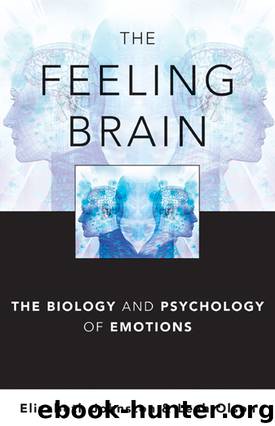The Feeling Brain by Elizabeth Johnston

Author:Elizabeth Johnston
Language: eng
Format: epub
Publisher: W. W. Norton & Company
The Default Mode Network and Autobiographical Recall
The linkage of autobiographical remembering with other aspects of mental function, such as prospection or future planning and imagination, has recently cohered in a newly discovered brain system called the default mode network (DMN). The “mental time travel” described by Tulving and his colleagues has been linked to a set of brain regions that seem to become active by default when the brain is not otherwise engaged in externally oriented tasks. Just as with Olds and Milner’s fortuitous discovery of the reward system, the discovery of the DMN was an accidental by-product of studies designed for other purposes. Neuroimaging researchers realized that the brain was highly active during the so-called rest periods between assigned tasks, and, even further, that some brain areas actually became less rather than more active when engaged in externally oriented experimenter-defined activities.
These areas in the medial prefrontal cortex (both ventral and dorsal)—the posterior cingulate and retrosplenial cortex behind it, the inferior parietal lobule, the lateral temporal cortex, and the hippocampal formation—have been shown to be tightly interconnected and coactivated in a wide variety of tasks in meta-analytic studies (Gusnard, Akbudak, Shulman, & Raichle, 2001; Raichle, MacLeod, Snyder, Powers, & Gusnard, 2001; Shulman et al., 1997; Spreng, Mar, & Kim, 2009). Brain activity patterns when engaged in reminiscing about the personal past turn out to overlap extensively with characteristic patterns of activity in other sorts of tasks, like the mind reading involved in theory of mind tasks asking participants to take other people’s perspectives, contemplating possible happenings in the personal future, solving moral conundrums, and imagining navigating familiar environments. Thinking about what links these diverse tasks led to a reconception of autobiographical memory as part of a larger set of mental simulation processes that activate the DMN. As Buckner, Andrews-Hanna, and Schacter state in their comprehensive 2008 review, an important function of “the default mode network is to facilitate flexible, self-relevant mental exploration—simulations—that provide a means to anticipate and evaluate upcoming events before they happen” (p. 2). These “simulations” or “self-projections” (Buckner & Carroll, 2008) that encompass autobiographical remembering and future planning are a crucial part of emotional life, enabling us to more flexibly respond to and contemplate situations that arise in our everyday lives. As memory researchers Daniel Schacter and Donna Rose Addis (2007) point out, this view of episodic memory (see Box 8.1) as only one of the outputs of a simulation system that is also active in future thinking, helps make more sense of its constructive rather than literal nature. Occasional errors in autobiographical remembering are part and parcel of the adaptive system that helps us navigate the complex social world and manage our emotional reactions to what arises.
Download
This site does not store any files on its server. We only index and link to content provided by other sites. Please contact the content providers to delete copyright contents if any and email us, we'll remove relevant links or contents immediately.
Periodization Training for Sports by Tudor Bompa(8171)
Why We Sleep: Unlocking the Power of Sleep and Dreams by Matthew Walker(6618)
Paper Towns by Green John(5092)
The Immortal Life of Henrietta Lacks by Rebecca Skloot(4526)
The Sports Rules Book by Human Kinetics(4296)
Dynamic Alignment Through Imagery by Eric Franklin(4118)
ACSM's Complete Guide to Fitness & Health by ACSM(3989)
Kaplan MCAT Organic Chemistry Review: Created for MCAT 2015 (Kaplan Test Prep) by Kaplan(3940)
Introduction to Kinesiology by Shirl J. Hoffman(3726)
Livewired by David Eagleman(3685)
The Death of the Heart by Elizabeth Bowen(3553)
The River of Consciousness by Oliver Sacks(3542)
Alchemy and Alchemists by C. J. S. Thompson(3451)
Bad Pharma by Ben Goldacre(3357)
Descartes' Error by Antonio Damasio(3230)
The Emperor of All Maladies: A Biography of Cancer by Siddhartha Mukherjee(3068)
The Gene: An Intimate History by Siddhartha Mukherjee(3048)
The Fate of Rome: Climate, Disease, and the End of an Empire (The Princeton History of the Ancient World) by Kyle Harper(3003)
Kaplan MCAT Behavioral Sciences Review: Created for MCAT 2015 (Kaplan Test Prep) by Kaplan(2941)
